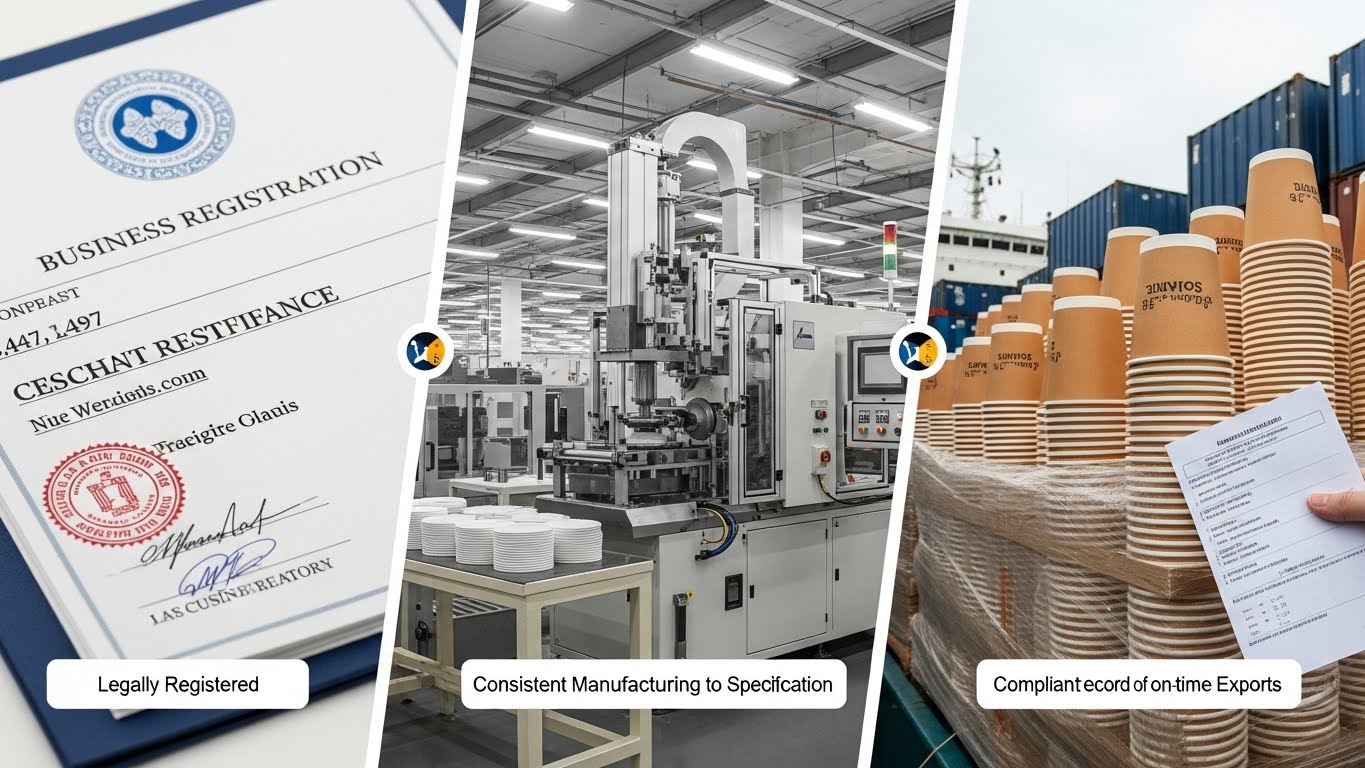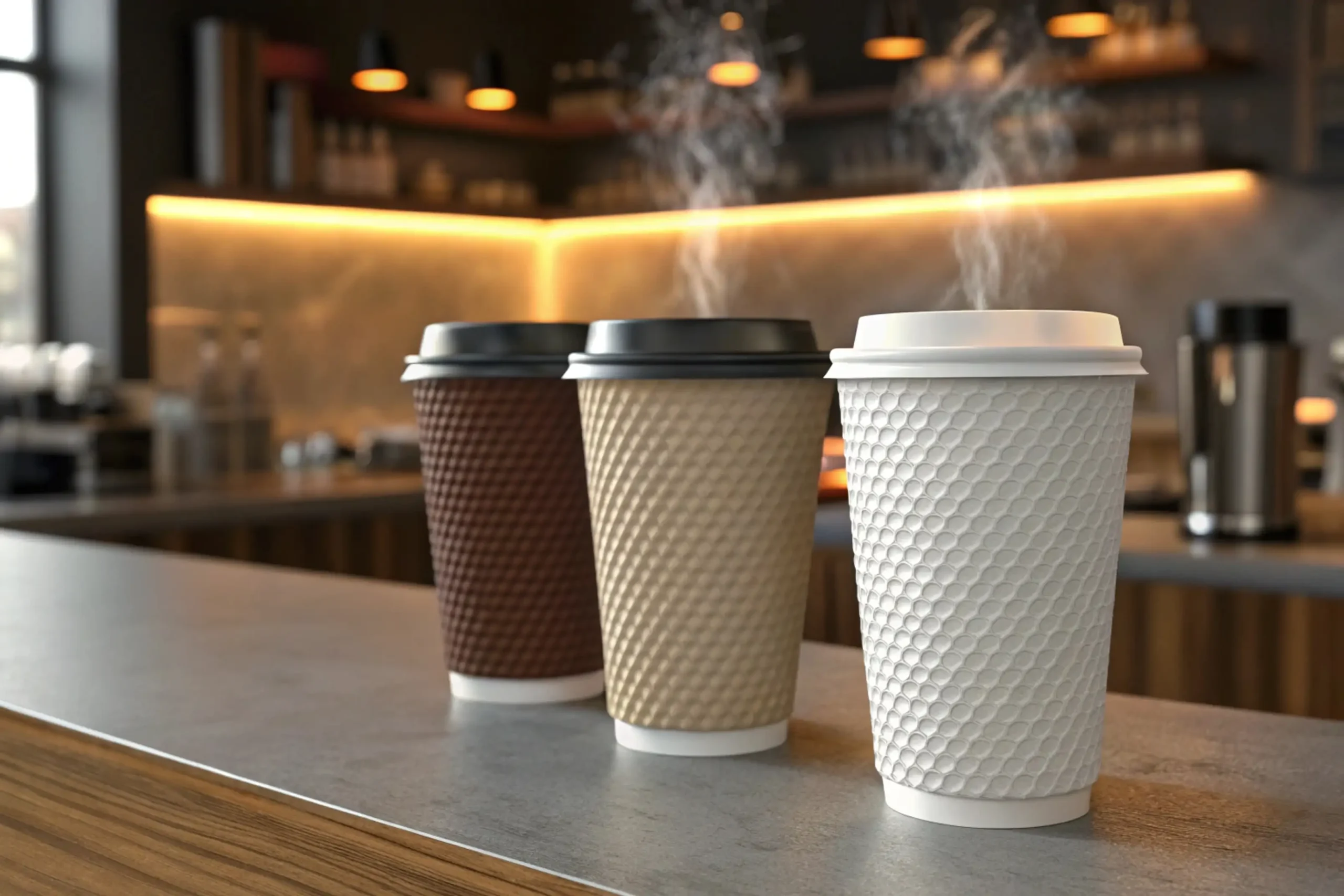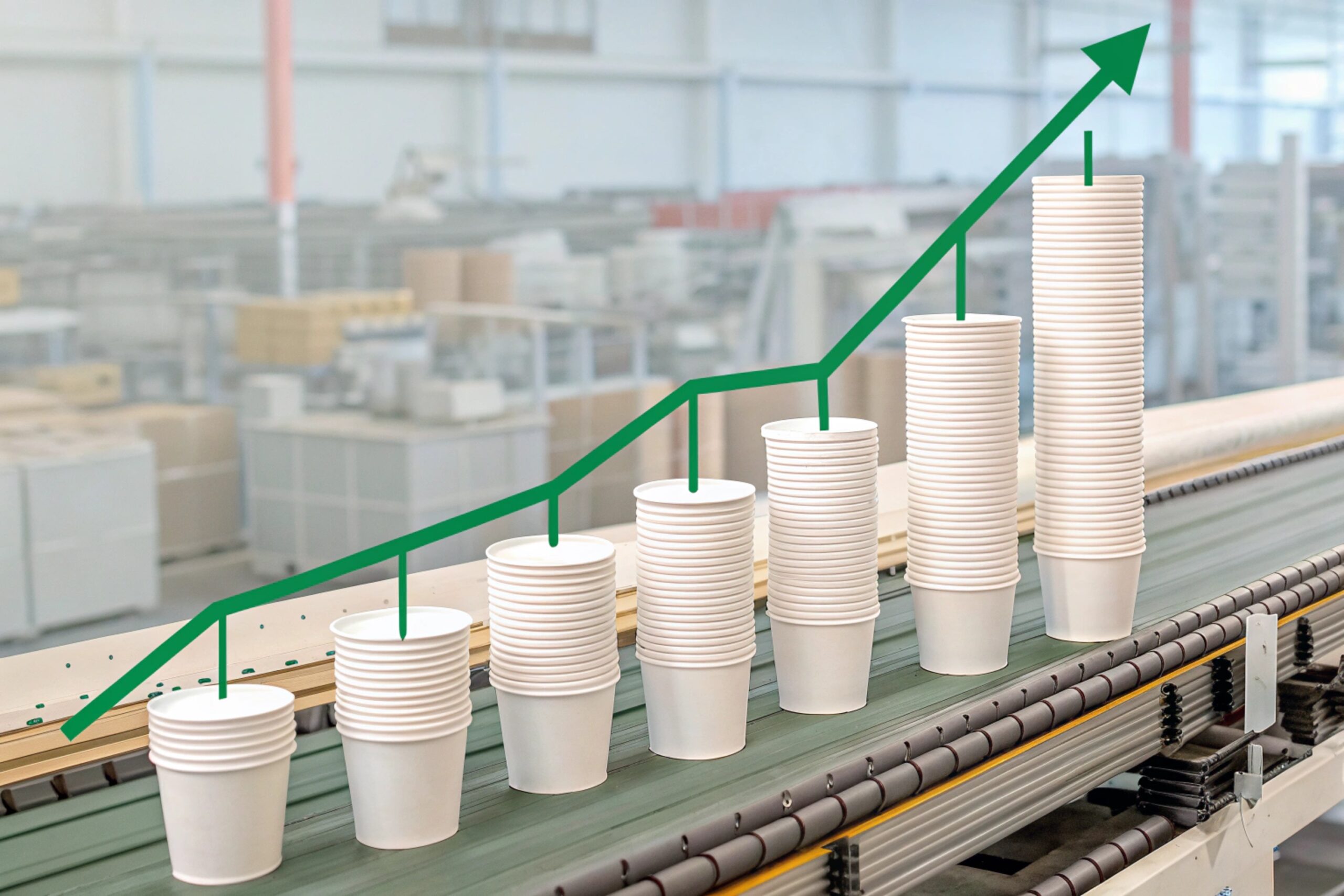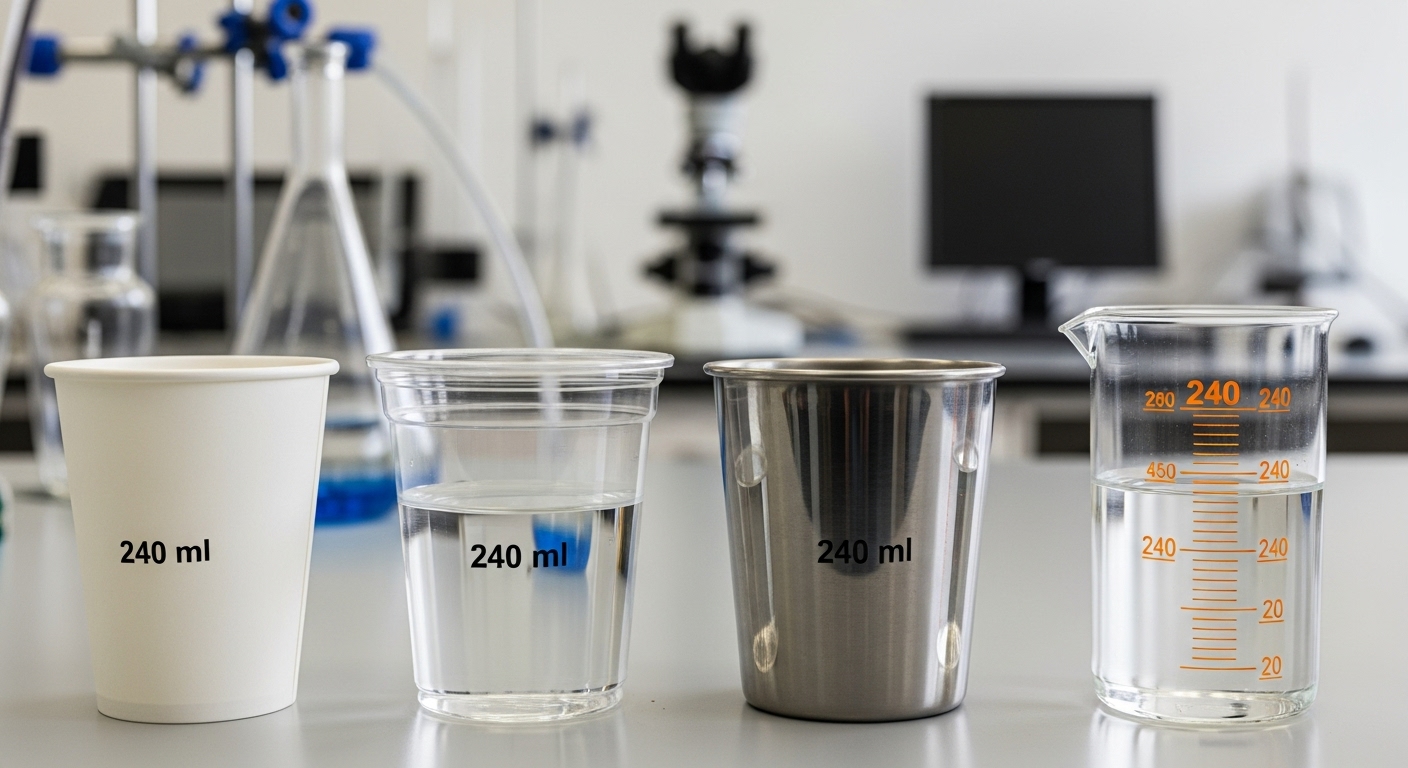When a coffee chain prepares takeaway beverages, one critical decision often gets overlooked: What is the ideal temperature for serving coffee in disposable cups?
Procurement managers and wholesale buyers in the food and beverage sector must balance customer safety, taste, and packaging performance. Temperature not only influences flavor but also determines whether the container protects the drinker from burns or structural failure.
The ideal serving temperature for takeaway coffee is between 135–150°F (57–66°C), according to the National Coffee Association (NCA). Coffee brewed at 195–205°F (90–96°C) should be allowed to cool slightly before serving in takeaway cups. Paper cups with double walls or sleeves, and PP plastic cups, provide the safest protection at these temperatures. Serving above 160°F (71°C) risks burns and may weaken certain cup materials. For cold beverages, PET and RPET cups perform best, while PS thermoforming cups remain suitable only for chilled drinks. (Source: National Coffee Association, Coffee Brewing Guide).
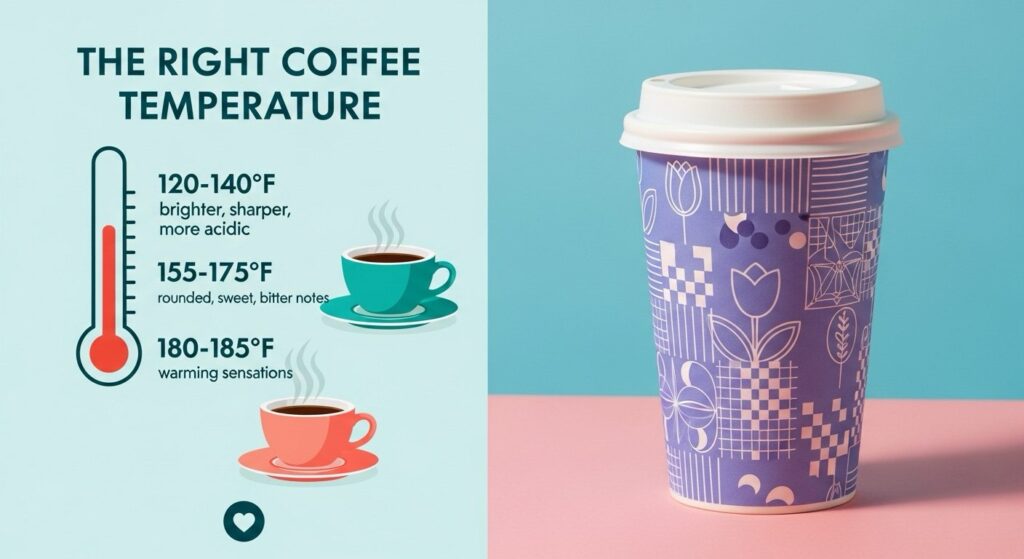
1. Coffee Containers and Heat Resistance
1.1 Single Wall Paper Cups + Sleeves
Single wall paper cups are the most common option in the takeaway coffee market. They are cost-effective and used by global chains such as Starbucks.
However, they require an additional sleeve when serving hot coffee above 135°F to prevent burns. For procurement teams, this means considering both cup and sleeve in supply planning.
When using single wall paper cups without sleeves, the outer surface can become uncomfortably hot, reaching around 65–70 °C when filled with freshly brewed coffee (90–95 °C).
With sleeves added, the outer surface temperature is significantly reduced to about 45–50 °C, making the cup easier and safer to hold.
This means the sleeve can lower the surface temperature by 15–20 °C, improving user comfort without affecting the beverage’s actual temperature inside the cup.
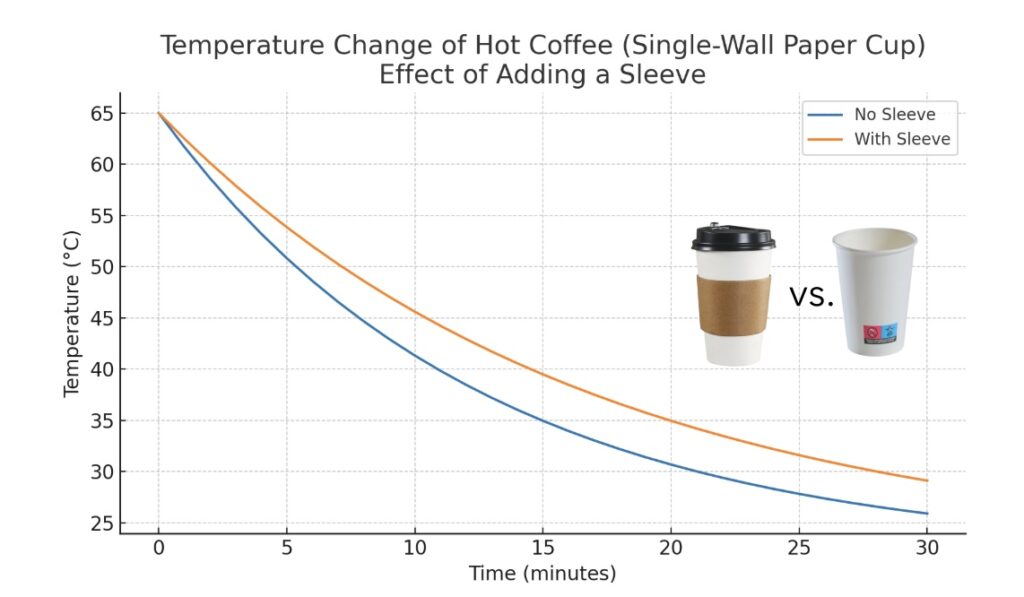
1.2 Double-Walled and Ripple-Walled Paper Cups
Double wall and ripple wall paper cups provide built-in insulation.
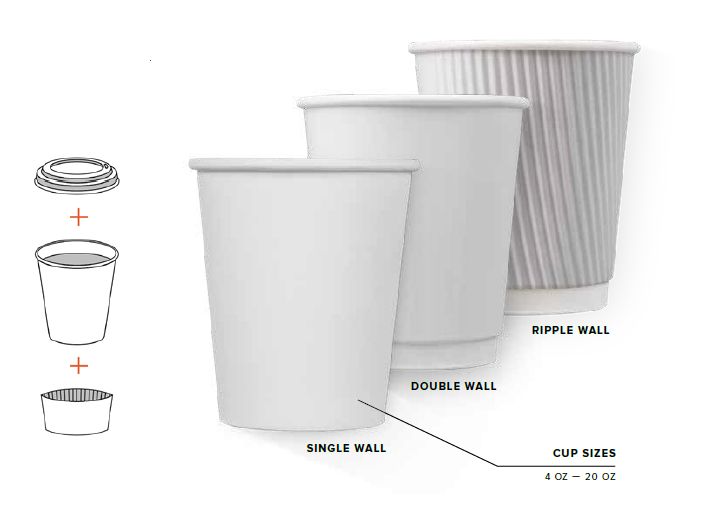
They eliminate the need for a sleeve, reducing unit handling costs. They also deliver a stronger brand experience, as the outer wall can be custom printed without being covered by an additional sleeve.
This makes them an attractive option for coffee chains seeking a clean, premium image.
1.3 Plastic Cup Options: PET, PP, and PS
- PET (RPET) Cups: Clear, durable, and recyclable. They are widely used for iced lattes, cold brews, and smoothies. RPET adds sustainability by incorporating recycled material. Not suitable for hot liquids above 60°C.
- PP Injection Plastic Cups: Resistant to high heat, they are suitable for both hot and cold beverages. This makes them popular in bubble tea and fast-growing coffee takeaway chains.
- PS Thermoforming Cups: Lightweight and cost-efficient, PS is generally used for cold drinks. It is not recommended for hot beverages because of lower heat tolerance.
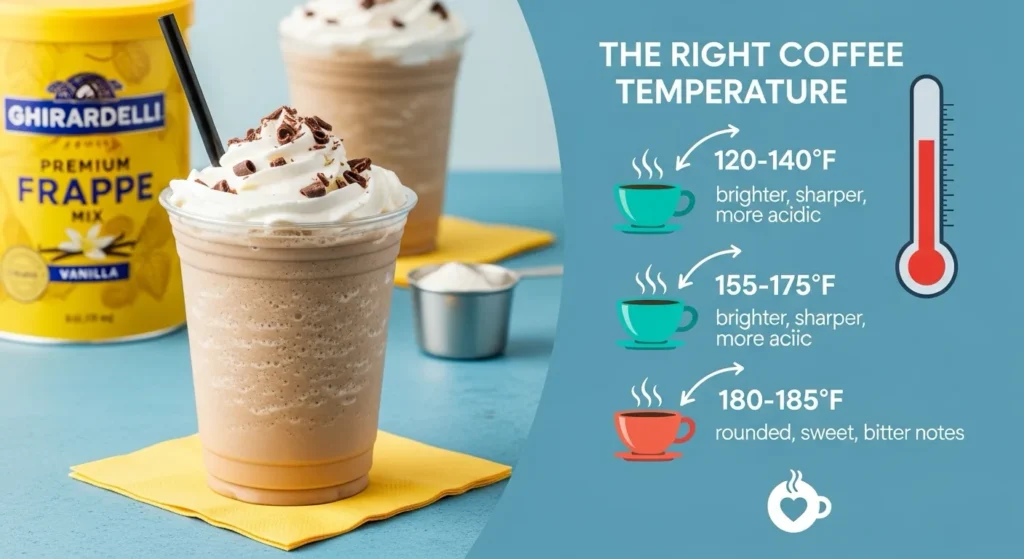
1.4 Paper vs Plastic: Which to Choose?
| Cup Type | Heat Resistance | Typical Use Case | Insulation Required | Sustainability Option |
|---|---|---|---|---|
| Single Wall Paper Cup | Hot drinks up to 150°F | Standard takeaway coffee | Needs sleeve | Recyclable, FSC-certified |
| Double Wall Paper Cup | Hot drinks 135–160°F | Premium takeaway coffee | No sleeve needed | Compostable coating available |
| PET (RPET) Cup | Cold only (below 130°F) | Iced coffee, smoothies | Not applicable | RPET recycled option |
| PP Injection Cup | Hot & Cold up to 212°F | Bubble tea, hot coffee | No sleeve needed | Widely recyclable |
| PS Thermoforming Cup | 0- 203°F | Cold or hot drinks | Not applicable | Low recyclability |
Procurement managers must align cup choice with beverage type, sustainability goals, and customer expectations.
2. Coffee Taste: Hot vs Cold Serving
2.1 Hot Coffee
The recommended drinking range for hot coffee is 135–150°F (57–66°C). At this level, the drink retains aromatic compounds without overwhelming the tongue. Serving coffee hotter than 160°F exposes consumers to burn risks and may cause paper or PS cups to soften. Double wall paper cups and PP cups provide the safest handling for hot drinks.
Coffee should be served in takeaway cups at 135–150°F (57–66°C) to balance taste and safety. Paper double wall cups and PP plastic cups are designed to withstand this temperature, while PET and PS cups are recommended only for cold beverages.
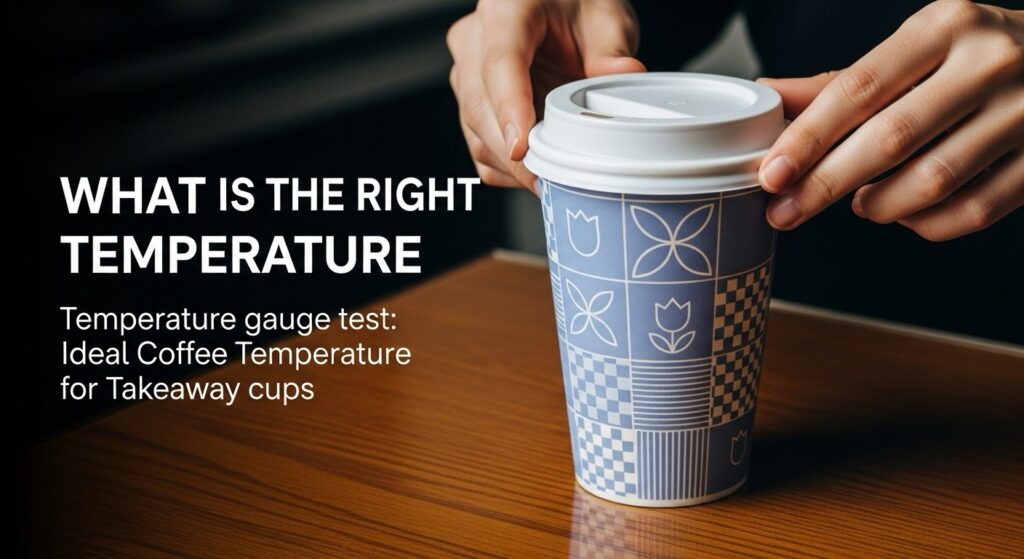
2.2 Cold Coffee Options
Cold brew coffee, iced lattes, and frappes require entirely different packaging considerations. Cold brew is typically brewed at 35–70°F (2–21°C), and must be kept chilled for flavor stability. For these drinks:
- PET and RPET cups provide clarity, enhancing the layered appearance of lattes or frappes.
- Paper cups can hold cold drinks but may become soggy without PE or water-based coating.
- PS cups are an economical choice but limited in recyclability.
Table: Hot vs Cold Coffee Packaging
| Beverage Type | Ideal Serving Temp | Recommended Cup Type |
|---|---|---|
| Espresso-based hot coffee | 135–150°F (57–66°C) | Double wall paper cup, PP cup |
| Black coffee | 140–151°F (60–66°C) | Single wall paper cup + sleeve |
| Cold brew | 35–70°F (2–21°C) | PET (RPET) cup |
| Iced latte/frappe | 40–50°F (4–10°C) | PET (RPET) cup, PS cup |
3. Brewing, Aroma, and Bean Flavor
3.1 Brewing Temperature Guidelines
Coffee brewing temperature determines flavor extraction. According to the Specialty Coffee Association (SCA), the recommended brewing range is 195–205°F (90–96°C). Different methods require small adjustments:
- Pour-over: 200–205°F, accounting for heat loss.
- French Press: 200–205°F, retains stable temperature during steeping.
- Espresso: 190–196°F.
- Cold Brew: brewed with cold or room temperature water, typically 35–70°F.
3.2 Flavor and Aroma at Serving
Flavor peaks at 135–150°F. Cooling coffee allows volatile compounds to emerge, reducing bitterness and improving aroma clarity. Black coffee drinkers may prefer the higher end (58–66°C), while milk-based coffee drinks often taste better closer to 60°C.
3.3 Roasting and Temperature Impact
- Light roast: higher acidity, best served slightly cooler.
- Dark roast: bolder flavors, tolerates hotter serving.
- Medium roast: balanced, aligns with mainstream coffee chains’ offerings.
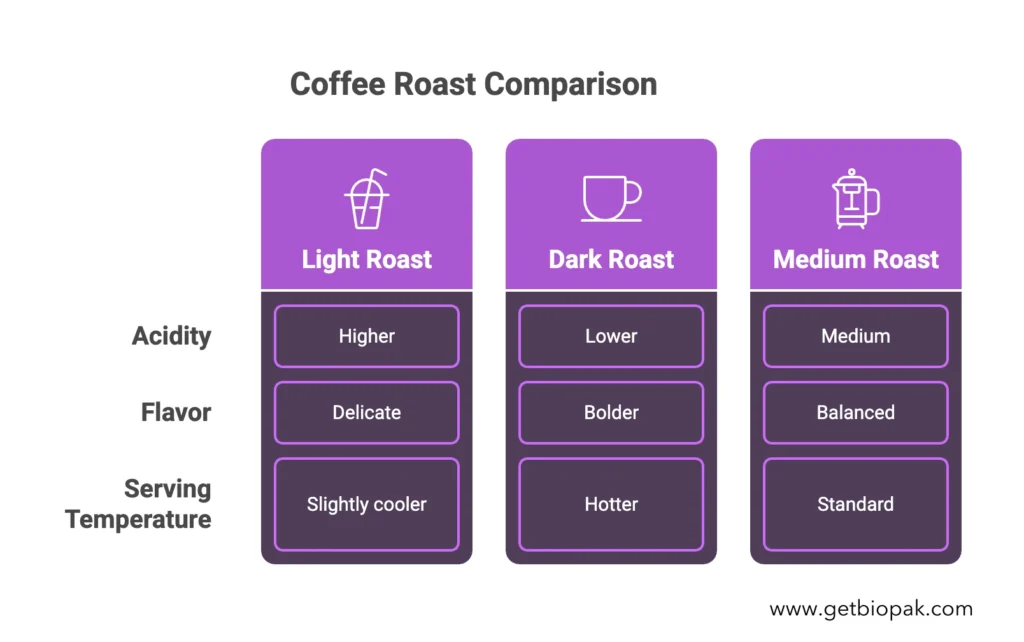
4. Safety Standards and Customer Protection
4.1 Industry Guidelines
- SCA recommends brewing between 195–205°F.
- The NCA suggests serving coffee between 135–150°F.
- Food safety authorities advise avoiding service above 160°F to reduce liability.
4.2 Customer Safety
Coffee chains must prioritize consumer safety. Burn incidents have caused lawsuits in the industry, most notably the 1994 McDonald’s case. Using insulated paper cups, secure lids, and proper handling procedures protects both consumers and brand reputation.
4.3 Takeaway Packaging Responsibility
As a supplier, I know buyers demand reliability and compliance. Get Bio Pak provides certified, food-safe, customized paper cups that meet FDA, HACCP, and ISO standards. Procurement managers can review our quality and service commitments to ensure compliance in global supply chains.
About Get Bio Pak Co., Ltd.
At Get Bio Pak Co., Ltd., we manufacture customized coffee paper cups and provide eco-friendly food packaging solutions. With more than 12 years of experience, we serve global coffee chains, foodservice brands, and wholesale distributors. Our product line includes custom paper cups printing, ice cream paper cups, and packaging designed for both hot and cold beverages.
We prioritize sustainability through eco initiatives and global certifications. Learn more about our company in About Us or explore our insights on the top 6 paper cup companies in China.
For wholesale inquiries or bulk orders, please contact us.
Conclusion
To recap:
- Cup selection determines whether beverages stay safe and enjoyable.
- Hot coffee should be served between 135–150°F for taste and protection.
- Brewing standards influence flavor, and serving temperature unlocks aroma.
- Industry safety guidelines protect consumers and brands alike.
For coffee chains and procurement managers, the takeaway is clear: correct temperature management combined with the right takeaway packaging is essential. Partner with Get Bio Pak Co., Ltd. to secure customized coffee paper cups that meet global safety, flavor, and branding standards.
FAQ
What temperature is coffee served at Starbucks?
Starbucks typically serves its hot coffee beverages at around 150°F to 170°F (65°C to 77°C). However, extra hot drinks can reach up to 180°F (82°C). This ensures customers get a hot but drinkable beverage without the risk of extreme burns.
What is the golden standard coffee temperature?
The golden standard for serving coffee is generally 155°F to 175°F (68°C to 80°C). This range balances flavor extraction, aroma release, and drinkability. It allows coffee drinkers to enjoy the taste profile while minimizing scalding risks compared to excessively high temperatures.
What is McDonald’s coffee temperature now?
Currently, McDonald’s serves coffee at approximately 175°F to 180°F (79°C to 82°C). This is slightly hotter than some coffee shops, but within food service safety standards. The temperature provides customers with a long-lasting hot beverage experience while reducing the risk of previous overheating controversies.
What is the best temperature for barista coffee?
Baristas generally recommend serving coffee at 150°F to 160°F (65°C to 71°C). This temperature allows the coffee’s flavors to shine without overpowering heat. It also enhances the sensory experience, giving customers both warmth and full taste without risking burns from extremely hot liquids.
What temperature does McDonald’s keep their coffee at?
McDonald’s typically maintains its coffee at around 175°F (79°C). This standard ensures the beverage stays hot for longer while being served fresh. Although hotter than some competitors, it meets internal safety protocols designed to provide consistency across all McDonald’s locations.
How hot was McDonald’s coffee?
Historically, McDonald’s coffee was served at 180°F to 190°F (82°C to 88°C), far hotter than most coffee chains. This extreme temperature led to lawsuits and customer injuries. After public scrutiny, McDonald’s adjusted its coffee service temperature to safer levels while still keeping drinks hot.


